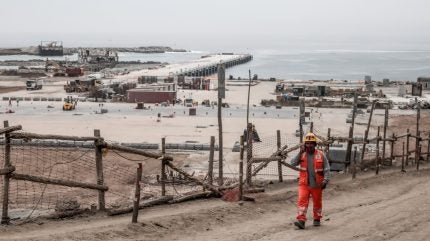
For more than 1,500 years, China’s Silk Road connected trade routes through Europe and East Asia, extending across 6,437km (4,000 miles) of landscapes like the Gobi Desert and the Pamir Mountains to facilitate the exchange of goods and ideas between the East and West. 570 years later, Beijing has even more ambitious plans.
Launched by President Xi Jinping in 2013, the Belt and Road Initiative (BRI) has enticed more than 150 countries to sign up for Chinese investment in key infrastructure; from pipelines, power plants and telecoms networks, to airports, roads, railways and ports.
Some see the BRI, or so-called ‘New Silk Road’, as a harbinger of a new era of trade and growth for developing economies in Asia, Africa and Latin America.
Sceptics say China is using the BRI to lay a debt trap for borrowing governments – and use its right to retain the right to demand repayment at any time for geopolitical leverage over issues such as Taiwan’s sovereignty or the treatment of Uyghurs.
Governments across Latin America are increasingly falling into the sceptic camp. Last Saturday (23 March), the Peruvian Government terminated the exclusive right of COSCO, the Chinese state-owned shipping company involved in numerous BRI deals, to operate the Chancay megaport COSCO is currently building.
Just 70km north of Peru’s capital Lima, Chancay is set to become one of Latin America’s largest deepwater ports once inaugurated during the Asia-Pacific Economic Cooperation (APEC) summit in November, as COSCO intends. Chancay is more than 70% complete, as reported by the Peruvian outlet Andina.
COSCO did not respond to request for comment.
How will Peru’s Chancay Port affect Latin American trade?
While promoting Chinese aims – and trade – overseas remains the overarching goal of the BRI, Beijing’s strategy “has evolved over the last couple of years”, according to Rory Green, chief China economist and head of Asia research at TS Lombard.
“China’s BRI investment has moved away from unrestrained outbound investment to a much more strategic approach”, Green tells Ship Technology. “BRI and outward direct investment are now focused on a few core objectives; the supply of essential raw materials, access to major markets, acquisition of tech IP – and geopolitics.”
Such aims are evident with the $3.5bn COSCO-Chancay Port project. Dubbed “the gateway from South America to Asia” by Mario de las Casas, institutional affairs manager of COSCO, Chancay will create a direct route from South America to China.
This will reduce ships’ travel time by ten days, compared to the over 35-day journey between South America and China, due to forced stops in Central America, Mexico, or the US.
Chancay Port’s deepwater facilities will also mean it can handle container ships unable to dock elsewhere along South America’s Pacific coast. Similar support was expressed by Leo Huisman, the regional managing director of the Americas for APM Terminals for Maersk.
During a Port of LA conference call earlier this month, Huisman described how COSCO “is building a super-modern port with an automated yard and state-of-the-art equipment, and they’re working in terms of redefining how shipping lines will service the west coast of South America.”
A protectionist spanner in China’s BRI works
The Peruvian Government’s decision to withdraw COSCO’s exclusive operational control over Chancay Port was criticised by the shipping giant, which said the decision threatened the “security and legal stability of investment”.
Pressure has been ramping up on Latin American nations to reduce dependence on Chinese FDI for ports, railways and other infrastructural projects. This has been largely fuelled by the US.
Washington has expressed concern to Peru that China is gaining excessive control of large swathes of the Andean nation’s infrastructure, also pointing out Beijing’s control over electrical supply to Lima.
China Southern Power Grid International bought Peru’s electricity business for $2.9bn last year, the Financial Times reported, while Three Gorges Corporation – another Chinese company – bought the rest of Lima’s electricity supply in 2020.
Nonetheless, Peru's government awarded a $405m contract to a second Chinese company, Jinzhao, for the construction of the country’s third-largest port, San Juan de Marcona, last Friday (22 March).
Which Latin American countries is China investing in most heavily?
Amid the Chancay Port saga, Peru remains the fifth largest recipient of Chinese FDI in Latin America, data from CEIC shows. Beijing has focused heavily on exporting Peru’s large commodities market, led by copper, gold, gas, and grapes.
As the largest economy (and country) in South America, Brazil is unsurprisingly China’s most active trade partner in the region. President Lula, who is keen to promote de-dollarisation and Latin American self-sufficiency, has welcomed Xi Jinping’s FDI and continued exportation of soybeans, iron ore and petroleum.
Mexico is second, largely due to its access to US markets, key for China as US-China tensions and sanctions ramp up.
Copper and lithium-rich Chile has seen Beijing invest heavily in its commodities market, heightening regional fears of exploitative ‘extractivismo’ (Extractivism) by China, the US or any other global power that has long held Latin America’s critical minerals in their sights.
“Moving forward, protectionism [in Latin America] is likely to gradually increase – in part from US pressure, but also rising local political concerns and a desire to protect domestic manufacturing and resources,” Green concludes.
“The reason we see only a slow ratchet up in protectionism is that China remains the dominant trade partner for many of these countries. Latin American leaders will be wary of alienating a key driver of economic activity.”
COSCO and its competitors, as well as Beijing and Washington, will be closely monitoring the Peruvian government’s next decision on Chancay Port and other key infrastructure.



